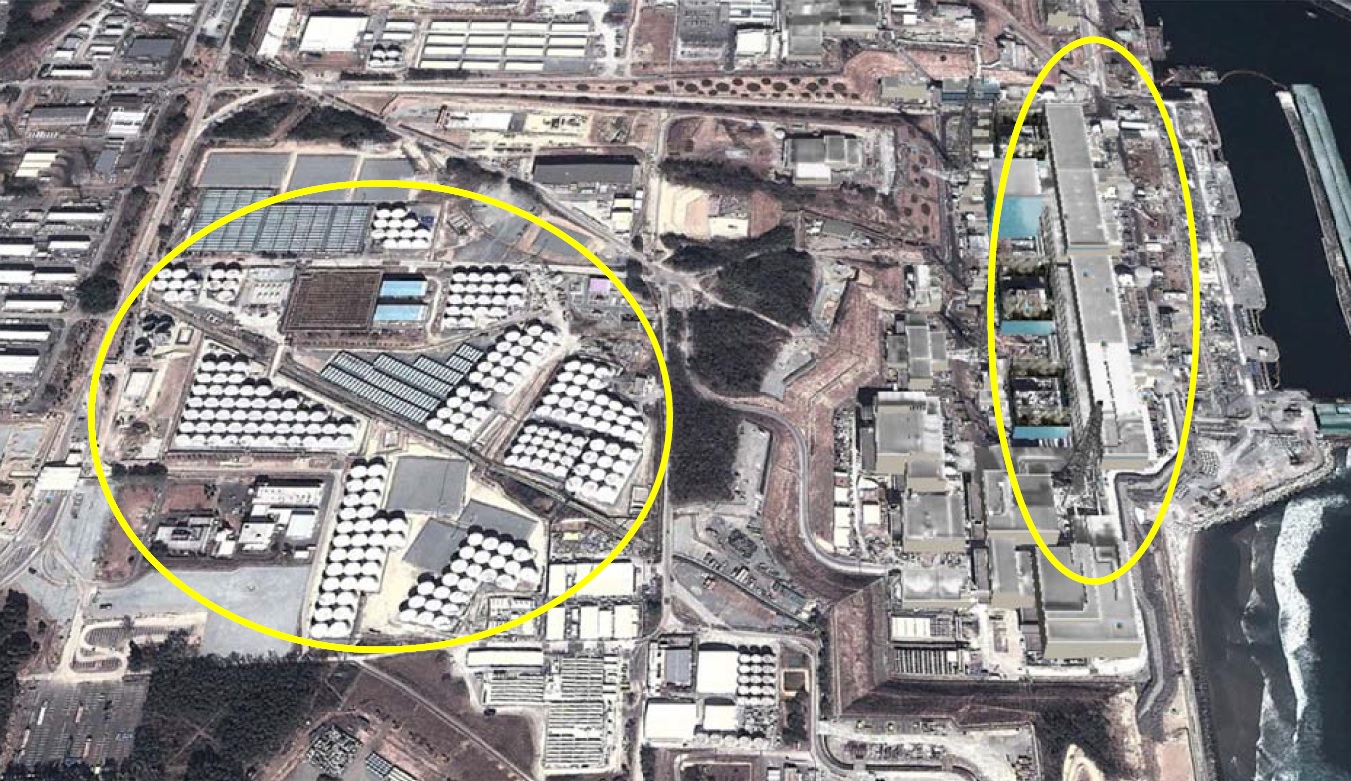
This photo shows the reactors (right) and the storage tanks for contaminated water (left) at Fukushima Daiichi on March 3, 2013 (Source: Google Earth)
In December 2011, the government of Japan announced with great fanfare that the nuclear reactors damaged in March at Fukushima Daiichi were in a state of “cold shutdown” and that the release of radioactive materials from the reactor containment vessels had been brought under control.
In August 2013, following months of worsening news, Masayuki Ono—acting nuclear power chief of the Tokyo Electric Power Company (TEPCO) that owns the reactors—sang a different tune, admitting that the utility was unable to control the release of radioactively contaminated water into the environment. These ongoing and uncontrollable discharges led Japan to declare this week that the leakage represented a “serious incident” rating a 3 on the International Nuclear Event Scale (distinct from the original accident at Fukushima, which rated a 7 on this scale).
Ongoing Water Leaks
In fact, the degree to which TEPCO could “control” the massive volume of radioactive water at the Fukushima Daiichi site was always in question. Soon after the accident began in March 2011, it became apparent that much of the cooling water being injected into the damaged reactor cores and spent fuel pools was leaking from the reactor vessels and primary containment vessels via unknown pathways and ending up in the reactor buildings and turbine building basements, as well as in various trenches and tunnels crisscrossing the site, some of which were not isolated from groundwater and tidewater. A number of temporary fixes were applied to prevent the ongoing release of large quantities of radioactive materials into the ocean. In addition, TEPCO installed a water processing system that was able to remove and concentrate one of the most troublesome radioactive isotopes in the cooling water, cesium-137, and built a vast farm of tanks to store water that was not being recycled for cooling. Yet these measures have been unable to prevent contaminated water from leaking from engineered structures into the soil. The leak from a storage tank of 300 tons of partially decontaminated water that TEPCO announced on August 19th of this year was the latest and most severe of a series of such releases.
At the same time that radioactive material is leaking into the soil beneath the site, one thousand metric tons of groundwater is flowing daily into Fukushima Daiichi from the inland mountains. About 400 tons is believed to be accumulating each day in the reactor buildings and turbine buildings, and the remainder is being discharged to the harbor. This provides a mechanism for the constant flushing of radioactive contamination in the soil below the reactors into the sea. TEPCO believes about 300 tons of the groundwater flowing daily into the harbor is becoming contaminated. It has begun to pump and store some of this groundwater but so far can only handle a fraction of the volume.
TEPCO has been evaluating a wide range of measures to attempt to stabilize the site, including construction of a so-called “ice wall” that would create a barrier of permafrost to divert the groundwater flow around the contaminated area. It has also finally requested international help. But the government of Japan, which has lost patience with TEPCO, has announced that it is taking the lead in developing emergency measures, although the extent to which the government will assume responsibility for dealing with the crisis is unclear
What Does It Mean?
Although the uncontrolled daily release of radioactivity into the environment represents a failure on the part of TEPCO to safely manage the Fukushima site, it does not yet pose a major public health threat comparable to the releases of radioactivity that occurred in the weeks following the accident, which were millions of times greater. The inability to safely contain the radioactivity at the site is first and foremost a threat to the workers who must report each day no matter how precarious the conditions. The contamination of more than ten workers in recent weeks, resulting in an expansion of areas where respiratory protection is required, has highlighted the dangers faced by personnel.
However, the situation is a stark reminder of how fragile things still are at Fukushima, which is especially alarming given the enormous quantity of radioactive material that still remains within the reactor cores and spent fuel pools. Things could rapidly get worse if, for example, additional wastewater tanks started to leak. And the potential for another earthquake that might cause soil liquefaction under the site, as reported by the Japan Times this week, raises the possibility of sudden and much larger releases. The international community should not be lured into a false sense of confidence during the periods when little news about Fukushima is being reported. The situation is dire and requires an urgent response.
